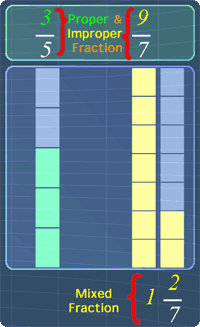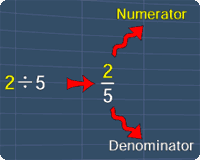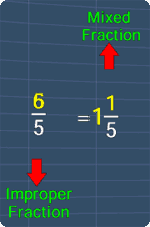
Understanding Fractions
Lesson Objective
Need help in
understanding
fractions? This
lesson will show
you
the basic ideas
on fractions and the common
terms used in
describing fractions...
About This Lesson
To begin
understanding fractions, this lesson introduces
you the basic ideas behind fractions.
This lesson will also shows the common terms used in describing fractions. These terms are:
You can proceed by reading the study tips first or watch the math video or try out the practice questions.
This lesson will also shows the common terms used in describing fractions. These terms are:
- Numerator
- Denominator
- Proper Fractions
- Improper Fractions
- Mixed Fractions
You can proceed by reading the study tips first or watch the math video or try out the practice questions.

Tip #1 - Numerator and Denominator
When we divide two numbers, we will usually
write the expression this way:
2÷5
Now, the above expression can also be written in the form of fraction as shown in the picture on the right.
Notice that, the fraction is divided into 2 parts. The upper part is the numerator and the lower part is the denominator.
The math video below will explain more.
2÷5
Now, the above expression can also be written in the form of fraction as shown in the picture on the right.
Notice that, the fraction is divided into 2 parts. The upper part is the numerator and the lower part is the denominator.
The math video below will explain more.

Tip #2 - Proper Fractions
When a fraction's numerator is lesser
than the denominator, this fraction is a proper
fraction. Below are some examples:
5/20 , 3/8 , 7/8
5/20 , 3/8 , 7/8

Tip #3 - Improper Fractions & Mixed Fractions
A fraction is considered as an improper fraction
when its numerator is greater
or equals to the denominator. Below are some examples:
8/7 , 2/1 , 20/6 , 5/5
Note that, mixed fraction is actually equivalent to proper fraction. The only difference is the way they are written.
The picture on the right illustrates this. The math video below will explain more on this.
8/7 , 2/1 , 20/6 , 5/5
Note that, mixed fraction is actually equivalent to proper fraction. The only difference is the way they are written.
The picture on the right illustrates this. The math video below will explain more on this.

Multiple Choice Questions (MCQ)
Now, let's try some MCQ questions to understand
this lesson better.
You can start by going through the series of questions on Understanding Fractions or pick your choice of question below.
You can start by going through the series of questions on Understanding Fractions or pick your choice of question below.
- Question 1 on the basics terms needed in understanding fractions
